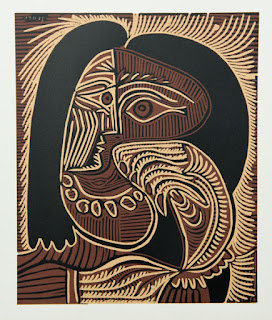Nolde: The Prophet 1912
Nolde: Head 1913
In both images Nolde is searching for some sort of primitive simplicity, however the woodcut allows him to be so much more direct and the qualities of the wood itself become part of the image, the frame/edge of the wood directly impacting on the power of the image.
Several contemporary artists have turned to printmaking when they have needed to refresh their approaches to image making, some such as Rauschenberg and Jasper Johns I have highlighted before, but there are many more artists to explore, historical heavyweights such as Rembrandt and Goya as well as those closer to our own time.
Ken Kiff is an artist I have already introduced as someone who 'drew in colour'. He often turned to printmaking as a way of combating artist's block. In the late 1980s Kiff made woodcuts, monotypes, lithographs and etchings. Each set of techniques gave him new materials to work with, and to think with, in the case of the images below, it's the wood grain that coheres the surface and direct cutting into the wood that simplifies and gives a quality to the images that makes them feel as if they have emerged from a folk tale.
Ken Kiff: woodcut
The other area to look at in relation to Kiff is his collaboration with master printmakers, such as Dorothea Wight, Mark Balakjian, Erik Hollgersson and Garner Tullis. This is also of great importance when considering the work of Johns and Rauschenberg who used the master printers Ken Tyler and Bill Goldston. When I first worked in Leeds because of my background in printmaking, (print was my DipAD craft option), I was employed as an editioner by the Spike Print workshop, at one time working to edition Terry Frost etchings, as well as working alongside him to develop the plates. It was a symbiotic relationship, he would know what he wanted and we would be expected to allow him to achieve the effects needed. I went on to set up the printmaking area at the College of Art, and spent many years working alongside students in the familiar capacity of mentor, trying to empathise with the student needs and not direct or censor an approach, attributes all learnt as a printer working with established artists.
Picasso: From the Vollard Suite
The one modern artist above all who demonstrated how printmaking could be used as a powerful and independent medium in its own right was Picasso. As a fellow Spaniard he was very aware of Goya's use of print, and is perhaps best known for the Vollard Suite of etchings (above). He creates a wide range of images including the Battle of Love, The Sculptor’s Studio, Rembrandt, the Minotaur, the Blind Minotaur and of course, portraits of Vollard, the man who commissioned him. The images show Picasso exploring a full range of etching techniques; sugar lift, dry point, soft and hard ground, aquatint, burnishing as well as variations in plate wiping techniques designed to make full use of the ink quality when printing. As well as etching he also took to the humble lino cut and produced some very powerful images.
Picasso: Lino cut
If you want to look at the full power of formal invention that Picasso has, the best place to look at this is by exploring his sketchbooks. He had already developed a drawing language before he took to print, this meant that he could concentrate on the possibilities each medium offered, without having to worry about 'what to do'.
Sketchbooks is yet another area I have yet to cover in this rambling blog but I will get there at some point.
I have used printmaking as an extension of drawing myself at various times, using silkscreen, lithography, monoprint, collographs and wood engraving, but probably my most successful ventures have been in etching. I have always found that the aquatint process in particular has helped me deal with tonal values. You have to be very clear and direct about the range and depth of values you need before putting plates in the acid, you can’t fiddle and mess around, which I like so many people have a tendency to do. Here's one I did a few years ago.
Etching with aquatint
See also:
The narrative tradition (Includes several printmakers)









.
ReplyDelete